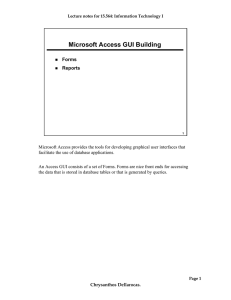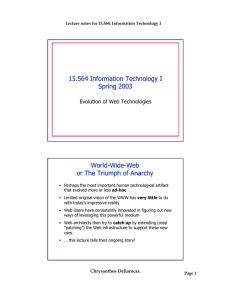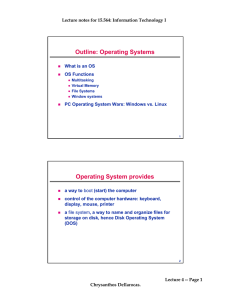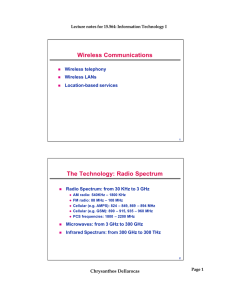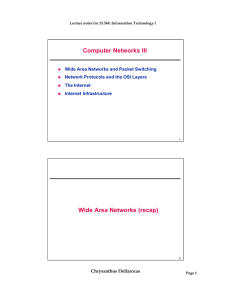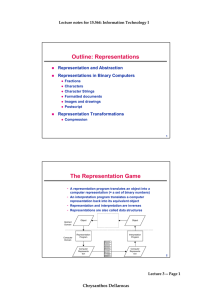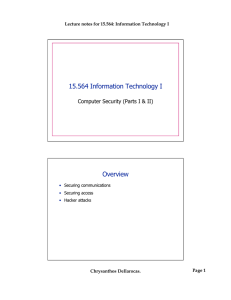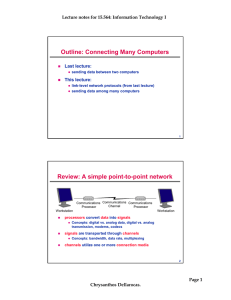Outline: Distributed Applications Networks Enable Distribution
advertisement
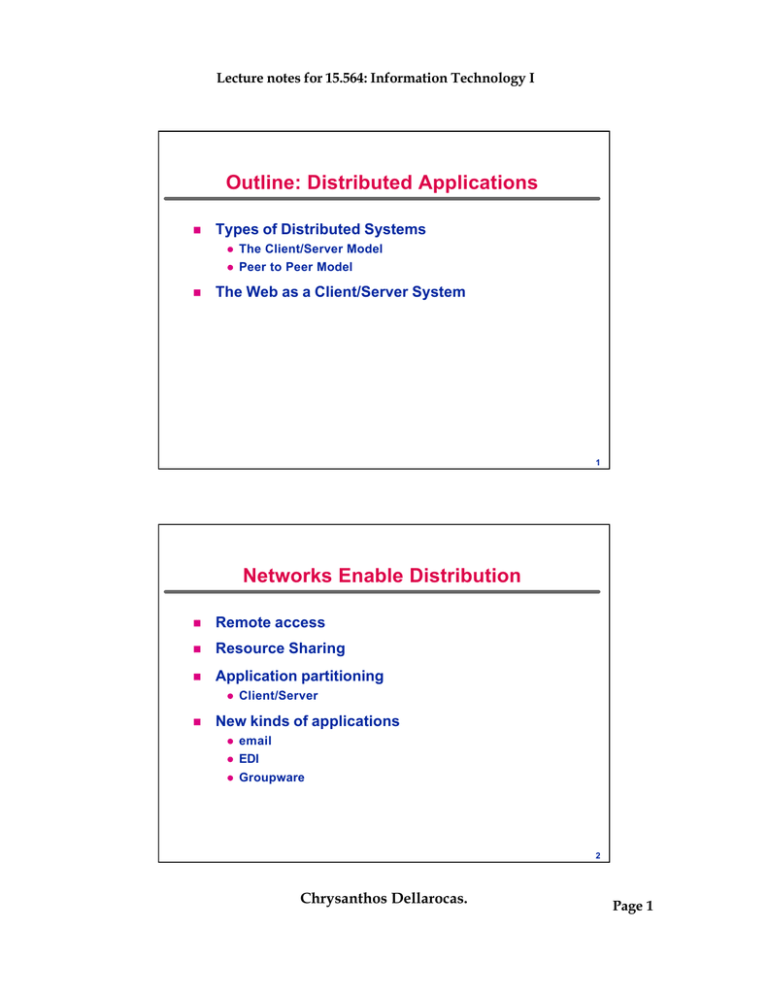
Lecture notes for 15.564: Information Technology I Outline: Distributed Applications � Types of Distributed Systems � � � The Client/Server Model Peer to Peer Model The Web as a Client/Server System 1 Networks Enable Distribution � Remote access � Resource Sharing � Application partitioning � � Client/Server New kinds of applications � email EDI � Groupware � 2 Chrysanthos Dellarocas. Page 1 Lecture notes for 15.564: Information Technology I Remote access � Centralized computer power � Several remote “dumb” terminals � Example: Early airline reservation systems workstation workstation workstation mainframe Modem Modem Modem Modem workstation workstation workstation 3 Resource sharing � Several stand-alone computers share expensive peripherals � � e.g. printers, plotters, scanners Example: Office LANs IBM Compatible IBM Compatible IBM Compatible Token Ring Laser Printer Disk Array Plotter 4 Chrysanthos Dellarocas. Page 2 Lecture notes for 15.564: Information Technology I Application Partitioning � Split the application functionality in several pieces � Place each piece in the machine where it can be handled most efficiently 5 The Client/Server Model � Split application functionality into two pieces: � CLIENT � Sends requests to server to access network resources Usually (but not always) is the piece that interfaces with user Usually a medium-end PC SERVER - Furnishes clients with application-specific resources - Databases - Huge disk drives - Connections to network - Accepts and responds to requests from several clients Usually a high-end PC, minicomputer, or mainframe 6 Chrysanthos Dellarocas. Page 3 Lecture notes for 15.564: Information Technology I Example: Database Servers SQL QUERY DATABASE SERVER DESKTOP PC (CLIENT) QUERY RESULTS - Contains all data - Runs queries, updates tables, and returns results - Runs user interface - Formulates queries and displays results 7 Example: File Servers Workstation Minicomputer Athena Network Minicomputer Workstation Diskless Athena workstations: - Provide user interface - Execute programs Athena file servers: - Store all programs - Store all user files 8 Chrysanthos Dellarocas. Page 4 Lecture notes for 15.564: Information Technology I Example: ATM machines (Transaction Servers) TRANSACTION BANK COMPUTER ATM TRANSACTION RESULTS - Checks account balances - Credits or debits customer account - Executes local dialog with customer - Control mechanical parts of ATM 9 How E-mail works Mail server of gates@microsoft.com Chris Dellarocas’s PC Bill Gates’ PC Sender composes message and presses “Send” Internet Mail server of Chris Dellarocas's email address 10 Chrysanthos Dellarocas. Page 5 Lecture notes for 15.564: Information Technology I How E-mail works Mail server of gates@microsoft.com Message is sent to sender’s mail server Chris Dellarocas’s PC Bill Gates’ PC Internet Mail server of Chris Dellarocas's email address 11 How E-mail works Mail server of gates@microsoft.com Chris Dellarocas’s PC Bill Gates’ PC Message is transferred to recipient’sInternet mail server and stays there until recipient retrieves it Chrysanthos Dellarocas. Mail server of Chris Dellarocas's email right address 12 Page 6 Lecture notes for 15.564: Information Technology I How E-mail works When recipient checks his email, mail client contacts mail server Mail server of gates@microsoft.com Bill Gates’ PC Chris Dellarocas’s PC Internet Mail server of Chris Dellarocas's email address 13 How E-mail works Mail server of gates@microsoft.com Chris Dellarocas’s PC Bill Gates’ PC Internet Mail server sends all unread messages back to client Mail server of Chris Dellarocas's email address 14 Chrysanthos Dellarocas. Page 7 Lecture notes for 15.564: Information Technology I How the Web works Open Location: http://web.mit.edu/sloan/www/index.html Web server Internet Web client (Netscape, Explorer, etc.) Domain Name Server 15 How the Web works Open Location: http://web.mit.edu/sloan/www/index.html 18.30.0.22 Looking up host: web.mit.edu ... Web server Web client (Netscape, Explorer, etc.) Internet What is the IP address of web.mit.edu? Domain Name Server Chrysanthos Dellarocas. 16 Page 8 Lecture notes for 15.564: Information Technology I How the Web works Open Location: http://web.mit.edu /sloan/www/index.html Here it is Contacting host: web.mit.edu ... Web server Web client (Netscape, Please send me file Explorer, etc.) /sloan/www/index.html Internet Domain Name Server 17 How the Web works Web server Web client (Netscape, Explorer, etc.) Internet Domain Name Server Chrysanthos Dellarocas. 18 Page 9 Lecture notes for 15.564: Information Technology I The WWW as a Client/Server System � Web Clients � � � � Web Servers � � � � Use HTTP protocol to connect to servers Request and display Web pages stored in servers Typical clients: Web browsers Listen for incoming connections from clients Use HTTP protocol to converse with clients Store and transmit Web pages to clients Any machine connected on the Internet can be a Web client and/or a Web server � all It takes is the right software 19 Client/Server Advantages � Price � � PC networks much cheaper than mainframes of equivalent computing power Scalability � Easy to grow/modernize system as needs change � Add clients Upgrade/add servers Vendor-Independence � Different system components can come from different vendors 20 Chrysanthos Dellarocas. Page 10 Lecture notes for 15.564: Information Technology I Client/Server Advantages (cont’d) � Availability � � If one machine goes down,your business stays up Superior User Interfaces � � Since user interface code is executed locally, interfaces can be arbitrarily elaborate End users can customize their interfaces to fit their individual needs/preferences 21 Client/Server Disadvantages � Maintenance � � � � Support tools lacking � � Parts don’t always work together Changes must propagate to all clients There are several possible culprits when something goes wrong With the client/server architecture, you locate or build tools yourself End User Education Required � End users need to know enough to customize their environment 22 Chrysanthos Dellarocas. Page 11 Lecture notes for 15.564: Information Technology I Types of Client/Server Systems � Issues: � � How much processing to do locally vs. in the server - PRESENTATION LAYER: User Interface APPLICATION LAYER: Application-specific processing DATA MNG LAYER: Actual storage of data - THIN CLIENTS: Only presentation layer In how many pieces to split the application - 2-tier, 3-tier and multi-tier architectures 23 Types of Client/Server Systems 24 Chrysanthos Dellarocas. Page 12 Lecture notes for 15.564: Information Technology I Fat Client Systems � Client implements presentation and application layer � local processing at client side � Example: Lotus Notes, Quicken � Advantages � � � better server scalability -- server needs to do less work less network traffic Disadvantages � � client is more complex; difficult to port to different platforms changes in server architecture are more likely to require changes in client 25 Thin Client Systems � Client only implements presentation layer � All processing is done at server side � Example: WWW � Advantages � � easy to port client to different architectures � client is decoupled from changes in the application Disadvantages � � server does all the work; might get easily saturated potentially long network delays 26 Chrysanthos Dellarocas. Page 13 Lecture notes for 15.564: Information Technology I 2-tiered vs. multi-tiered architectures � Limitations of 2-tiered client/server � � � single server server location fixed (otherwise clients need to change) What if… � � � � we want to add a second server to share the load we want to move the network location of a server we want to change our database from Sybase to Oracle … but do not want to modify all clients 27 Enter Middleware � Set of technologies that “glue” together clients and servers � Examples: � � Name servers Load balancers Server Client Name server Client Server 28 Chrysanthos Dellarocas. Page 14 Lecture notes for 15.564: Information Technology I Internet Middleware: Domain Name System � Internet hosts are referenced by name � � but, in reality, IP addresses are numbers � � florin.mit.edu 18.171.0.30 Internet has a set of Domain Name Servers that map names to IP addresses � � � Each server keeps “authoritative” information for its assigned domain only (e.g. Australia) Name queries go to server most local to requestor first Local server queries remote servers if name does not fall under its “jurisdiction” 29 How DNS works 30 Chrysanthos Dellarocas. Page 15 Lecture notes for 15.564: Information Technology I Original Web model (Client/Server) Web clients Web server Internet 31 Peer-to-Peer (P2P) web model 2. Bob has it Alice 1. Looking for picture 3. Data transfer Bob 32 Chrysanthos Dellarocas. Page 16 Lecture notes for 15.564: Information Technology I Applications of P2P model � File sharing � � Napster, Gnutella Utilization of spare computing power � � Auctioning of machine cycles SETI@home � Better information search � Highly robust distributed computing � No single point of failure 33 P2P Algorithms (1) � Centralized directory model - peers connect to a central directory to publish what information they offer for sharing Chrysanthos Dellarocas. Page 17 Lecture notes for 15.564: Information Technology I P2P Algorithms (2) � Flooded requests model � � a peer floods the request to directly connected peers (no central directory) which they further flood their peers etc. until the request is answered or a number of flooding steps are performed Issues with P2P � Everybody wants your files � … but few people want to give you theirs! � � Possible solution: Reputation mechanisms What is the business model? � Who can make money through P2P? 36 Chrysanthos Dellarocas. Page 18

